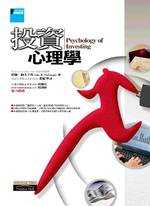
第七章 代表性與熟悉度
1. 《Beyond Greed And Fear: Understanding Behavioral Finance And the Psychology of Investing》
2. Hersh Shefrin and Meir Statman, "Making Sense of Beta, Size, and Book to Market", Journal of Portfolio Management(1995): 26-34.
3. Michael Solt and Meir Statman, "Good Companies, Bad Stocks", Journal of Portfolio Management(1989): 39-44.
4. Werner De Bondt and Richard Thaler, "Does the Stock Market Overreact?", Journal of Finance 40(1985): 793-808.
5. Nicholas Barberis, Andrei Shleifer, and Robert Vishny, "A Model of Investor Sentiment", Journal of Financial Economics 49(1998): 307-343.
6. Josef Lakonishok, Andrrei Shleifer, and Robert Vishny, "Contrarian Investment, Extrapolation, and Risk", Journal of Finance 48(1994): 1541-1578.
7. Werner De Bondt, "Betting on Trends: Intuitive Forecasts of Financial Risk and Return", International Journal of Forecasting 9(1993): 355-371.
8. Chip Heath and Amos Tversky, "Preference and Beliefs: Ambiguity and Competence in Choice Under Uncertainty", Journal of Risk and Uncertainty 4(1991): 5-28.
9. Gur Huberman, "Familiarity Breeds Investment", Columbia University working paper(Nov 1999).
10. Kenneth French and James Poterba, "Investor Diversification and International Equity Markets", American Economic Review 81(1991): 222-226.
11. Jun-Koo Kang and Rene Stulz, "Why is There a Home Bias? An Analysis of Foreign Portfolio Equity Ownership in Japan", Journal of Financial Economics 49(1997): 3-28.
12. N. Deogun, "The Legacy: Roberto Goizueta Led Coca-Cola Stock Surge, and Its Home Prospers", Wall Street Journal Oct. 20, 1997.
13. Joshua Coval and Tobias Moskowitz, "Home Bias at Home: Local Equity Preference in Domestic Portfolios", Journal of Finance 54(1999): 2045-2075.
14. E. Schultz, "Color Tile Offers Sad Lessons for Investors in 401(k) Plans", Wall Street Journal, June 5, 1996.
15. E. Schultz, "Workers Put Too Much in Their Employer's Stock", Wall Street Journal, Sep. 13, 1996.
16. M. Kilka and M. Weber, "Home Bias in International Stock Return Expectations", University Manheim working paper(1997).
17. K. Driscoll, J. Malcolm, M. Sirull, and P. Slotter, "1995 Gallup Survey of Defined Contribution Plan Participants", John Hancock Financial Services, Nov. 1995.
第八章 投資人社會化與投資狂熱
1. Marshall E. Blume, jean Crockett, and Irwin Friend, "Stock Ownership in the United States: Characteristics and Trends", Survey of Current Business 54(1974): 16-40.
2. Mark Hulbert, "Mail-Order Portfolios", Forbes, Feb. 26, 1996, page 118.
3. "Czech Markets Watchdog Chief Forced to Quit", Financial Times, April 11, 1997, page 3.
4. Michael S. Rashes, "Massively Confused Investors Making Conspicuously Ignorant Choices(MCI-MCIC)", Journal of Finance(2000).
5. Bard M. Barber and Terrance Odean, "Too Many Cooks Spoil the Profits: Investment Club Performance", Financial Analysts Journal(Jan./Feb. 2000): 17-25.
6. Tony Cook, "Six Moneymaking Lessons You Can Learn From America's Top Investing Club", Money Magazine 25(Dec. 1996): 88-93.
7. Brooke Harrington, "Popular Finance and the Sociology of Investing", Brown University working paper(2000).
8. Andrew Edgecliffe, "eToys Surges After Listing", Financial Times, May 21, 1999, page 29.
9. Michael Cooper, Orlin Dimitrov, and Raghavendra Rau, "A Rose.com by Any Other Name", Journal of Finance(2000).
10. 《The Big Board: A History of the New York Stock Market》
第九章 自我控制與決策制定
1. Kenneth Fisher and Meir Statman, "A Behavioral Framework for Time Diversification", Financial Analysts Journal(May/June 1999): 92.
2. Richard Thaler and Hersh Shefrin, "An Economic Theory of Self-Control", Journal of Political Economy 89(1981): 392-406.
3. Ted O'Donoghue and Matthew Rabin, "Doing It Now or Later", American Economic Review 89(1999): 103-124.
4. George Ainsle, "Derivation of 'Rational' Economic Behavior from Hyperbolic Discount Curves", American Economic Review 81(1991): 334-406.
5. Stephen Hoch and George Loewenstein, "Time-Inconsistent Preferences and Consumer Self-Control", Journal of Consumer Research 17(1991): 492-507.
6. George Akerlof, "Procrastination and Obedience", American Economic Review 81(1991): 1-19.
7. Richard Thaler, "Psychology and Savings Policies", American Economic Review 84(1994): 186-192.
8. Benjamin Ayers, Steven Kachelmeister, and John Robinson, "Why Do People Give Interest-Free Loans to the Government? An Experimental Study of Interim Tax Payments", Journal of the American Taxation Association 21(1999): 55-74.
9. Hersh Shefrin and Richard Thaler, "Mental Accounting, Saving, and Self-Control", In Choice Over Time, New York: Russell Sage Foundation, 1992.
10. Ted O'Donoghue and Matthew Rabin, "Choice and Procrastination", Cornell University working paper(April 2000).
專有名詞:
anomaly(異例)
artificial social consensus(人為社會共識)
Aversion to Debt(嫌惡負債)
Break Even Effect(損益打平效應)
disposition effect(處分效果)
Endowment effect(原賦效應)
familiarity bias(熟悉度偏誤)
glamour stocks(明星股)
home bias(母國偏誤)
homemade dividend(自製股利)
House Money Effect(賭資效應)
illusion of control(控制幻覺)
illusion of knowledge(知識幻覺)
mental account(心理帳戶)
mental accounting(心理會計)
mental budgeting(心理預算)
momentum investing(動能投資法)
psychological biases(心理偏誤)
representativeness bias(代表性偏誤)
risk aversion effect(風險嫌惡效應)
snake bite effect(蛇咬效應)
social consensus(社會共識)
social validation(社會認同)
status quo bias effect(現狀偏誤)
Sunk-Cost Effect(沉沒成本效應)
the regret of commission(作為後悔)
the regret of omission(不作為後悔)
相關文章:
投資心理學(Psychology of Investing)第1、2章參考資料
投資心理學(Psychology of Investing)3~6章參考資料
Behavioral Finance And Wealth Management(行為財務學與財富管理)第一部份參考資料
Behavioral Finance And Wealth Management(行為財務學與財富管理)第四部份參考資料
如何克服投資上的心理偏誤(非理性行為)
常見的投資心理偏誤(psychological biases)及其影響




0 意見:
張貼留言